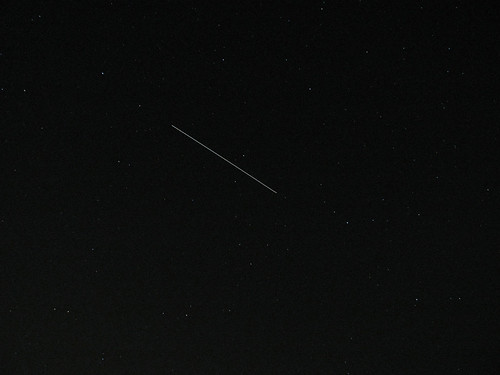Over the next few days, the International Space Station is making a series of excellent early evening passes over the western United States. I missed the one Friday night due to clouds, but Saturday (9/11) was perfectly clear.
With my off-the-shelf digital camera set to ISO 400, f/3.5, and using a 15 second exposure, I got a couple of very cool shots. Here it is rising in the northwest over my back yard:
[Click to embiggen. You really should go see the biggest versions of these shots to appreciate them.]
The bright star in the center is the orange giant Arcturus, a star much like the Sun but already in its death throes. The Sun will look like Arcturus in about 6 billion more years… and bear in mind that while it was only about half as bright as the space station when I took that shot, Arcturus was about a trillion times farther away.
Boy howdy.
Here is another one I took a few seconds later, when the ISS was passing just to the south and east of the constellation of Corona Borealis:

Corona Borealis is the U-shaped curved series of a half dozen stars just to the right of the right-hand end of the ISS streak. Note that the streak is longer than in the first photo; this was nearly overhead and the ISS was much closer to me than when it was on the horizon, so in those same 15 seconds it moved a lot further across the sky.
At this point, it was brighter than Jupiter in the sky. But then something amazing happened: it blinked out! I was expecting that: when it gets to a certain part of the sky, it enters Earth’s shadow. We see it fade out, but at that moment, from the astronauts point of view on board, they see the Sun setting behind the limb of the Earth. How cool is that? What surprised me was how quickly it faded; it couldn’t have taken more than a second or two. Usually it takes longer than that, fading slowly and turning reddish as it plunges into the Earth’s shadow.
I had a pair of binoculars with me, and while following the station was difficult – it was hauling! – I’m pretty sure I could see that it looked elongated to my eye. It’s as big as a football field now, 100 meters across, and in binocs it should look extended when overhead. I can’t be 100% sure I saw it that way, but I think so.
I stayed out a few more minutes just to use the binoculars and look at some old friends. I was able to spot the Dumbbell Nebula in Vulpecula, M13 in Hercules, and several star clusters and nebulae in Sagittarius. Just for grins, I took a 15 second shot of that last one:
You can see the teapot shape of Sagittarius right over my roof, and the fuzziness is the Milky Way galaxy itself: the combined light of billions of stars! I live in a mildly light-polluted area, so the sky is somewhat bright, but even so the Milky Way is easy to see in a short exposure. If you live with dark skies, then you can do a lot better than I can! Now is the time; get out there and observe!
And if you want to see the space station, and other satellites too, go to the Heavens Above website. Put in your latitude and longitude, and you’re off! It really is just that easy.
Related posts:
- ISS and Shuttle images!
- The Shuttle, the Station, and Orion
- Space Station crosses the dark side of the Moon!
- ISS, Shuttle transit the Sun!
- Two solar ISS transits!
- Amazing shot of ISS and Jupiter during daytime!